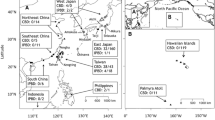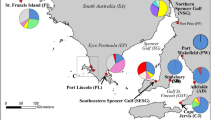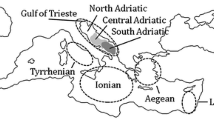Abstract
Sound management of coastal resources is based on science-based decisions. Bottlenose dolphins are found around Puerto Rico; however, limited information exists on the ecology, behavior, sex ratio, distribution patterns, and population structure presenting, challenges in managing the bottlenose dolphin as defined in the Marine Mammal Protection Act of 1972. We sequenced the mitochondrial control region (mtDNA-CR) of 27 live and 11 stranded dolphins from Puerto Rico, five stranded dolphins from Guadeloupe and included sequences from the North Atlantic and the Pacific Ocean. Our genetic data from the new samples indicates the presence of distinct genetic lineages (inshore—represented by coastal individuals) and worldwide-distributed form (represented by both coastal and offshore individuals) in Puerto Rico. DNA divergence between inshore/coastal and offshore haplotypes ranged from 4.34 to 6.58%. All haplotypes from Puerto Rico have been previously reported from the Caribbean and North Atlantic. Genetic analysis yielded a complex population structure without a clear geographic signal; an expected result from a highly mobile marine mammal. A clade consisting exclusively of coastal dolphins of the Caribbean and the western North Atlantic was recovered. Offshore haplotypes from the eastern and western North Atlantic were generally clustered with offshore haplotypes of the Caribbean. Coastal and offshore haplotypes from the Pacific differed from those from the Atlantic. When we partitioned the data by form (coastal vs. offshore) and ocean (Atlantic vs. Pacific), we detected significant population differentiation (FST = 0.4089), indicating limited gene flow between forms and across oceans.





Similar content being viewed by others
References
Allen SJ, Bryant KA, Kraus RH, Loneragan NR, Kopps AM, Brown AM, Gerber L, Krützen M (2016) Genetic isolation between coastal and fishery-impacted, offshore bottlenose dolphin (Tursiops spp.) populations. Mol Ecol 25(12):2735–2753
Armstrong RA, Singh H (2012) Mesophotic coral reefs of the Puerto Rico Shelf. In: Harris PT, Baker EK (eds) Seafloor geomorphology as benthic habitat: Geohab atlas of seafloor features and benthic habitat. Elsevier, London, pp 365–374
Avila IC, Kaschner K, Dormann CF (2018) Current global risks to marine mammals: taking stock of the threats. Biol Conserv 221:44–58
Baker CS, Flórez-González L, Abernethy B, Rosenbaum HC, Slade RW, Capella J, Bannister JL (1998) Mitochondrial DNA variation and material gene flow among humpback whales of the Southern Hemisphere. Mar Mamm Sci 14(4):721–737
Ballantine DL, Appeldoorn RS, Yoshioka P, Weil E, Armstrong R, Garcia JR, Otero E, Pagan F, Sherman C, Hernandez-Delgado EA, Bruckner A, Lilyestrom C (2008) Biology and ecology of the Puerto Rican coral reefs. In: Riegl BM, Dodge RE (eds) Coral reefs of the USA. Springer Science, Dordrecht, pp 375–406
Bandelt HJ, Foster P, Rohl A (1999) Median-joining networks for inferring intraspecific phylogenies. Mol Ecol Evol 16(1):37–48
Barragán-Barrera DC, May-Collado LJ, Quiñones-Lebrón SG, Caballero S (2013) Population at risk: low genetic diversity in bottlenose dolphins of Bocas del Toro, Panamá. Final Report. s.l.:IWC SC/65a/SM15
Barragán-Barrera DC, May-Collado LJ, Quiñones-Lebrón SG, Caballero S (2017) High genetic structure and low mitochondrial diversity in bottlenose dolphins of the Archipelago of Bocas del Toro, Panamá: a population at risk? PLoS ONE 12(12):1–22
Bearzi M, Saylan CA, Hwanga A (2009) Ecology and comparison of coastal and offshore bottlenose dolphins (Tursiops truncatus) in California. Mar Freshw Res 60:584–539
Bérubé M, Palsboll P (1996) Identification of sex in cetaceans by multiplexing with three ZFX and ZFY specific primers. Mol Ecol 5(2):283–287
Betancourt, L, Herrera-Moreno A, Beddall K (2012) Spatial distribution of humpback whales (Megaptera novaengliae) in Samana Bay, Dominican Republic. J Cetacean Res Manage SC-64-01:1–10
Bilgmann K, Möller LM, Harcourt RG, Kemper CM, Beheregaray LB (2011) The use of carcasses for the analysis of cetacean population genetic structure: a comparative study in two dolphin species. PLoS ONE 6(5):e20103. https://doi.org/10.1371/journal.pone.0020103
Boisseau O, Leaper R, Moscrop A, Embankment A (2006) Observations of small cetaceans in the Eastern Caribbean, St. Kitts & Nevis: International Whaling Commision Scientific Paper SC/58/SM24
Caballero S, Islas-Villanueva V, Tezanos-Pinto G, Duchene S, Delgado-Estrella A, Sanchez-Okrucky R, Mignucci-Giannoni AA (2011) Phylogeography, genetic diversity and population structure of common bottlenose dolphin in the Wider Caribbean inferred from analyses of mitochondrial DNA control region sequences and microsatellite loci: conservation and management implications. Anim Conserv 15(2):95–112
Castilho CS, Pedone-Valdez F, Bertuol F, Fruet P, Genoves RC, Di Tullio JC, Caon G, Hoffmann LS, Freitas TR (2015) Insights about the genetic diversity and population structure of an offshore group of common bottlenose dolphins (Tursiops truncatus) in the Mid-Atlantic. Genet Mol Res 14(2):3387–3399
Claro R, Lindeman KC (2003) Spawning aggregation sites of snapper and grouper species (Lutjanidae and Serranidae) on the insular shelf of Cuba. Gulf Caribb Res 14(2):91–106
Curry BE, Smith J (1997) Phylogeographic structure of the bottlenose dolphin (Tursiops truncatus): stock identification and implications for management. In: Dizon AE, Chivers SJ, Perrin WF (eds) Molecular genetics of marine mammals. Society for Marine Mammalogy, Kansas, pp 227–247
Darriba D, Taboada GL, Doalla R, Posada D (2012) jModelTest 2: more models, new heuristics and parallel computing. Nat Methods 9(8):772
Duarte-Fajardo MA, Barragán-Barrera DC, Correa-Cárdenas CA, Pérez-Ortega B, Farías-Curtidor N, Caballero S (2023) Mitochondrial DNA supports the low genetic diversity of Tursiops truncatus (Artiodactyla: Delphinidae) in Bocas del Toro, Panama and exhibits new Caribbean haplotypes. Rev Biol Trop 71(S4):e57291. https://doi.org/10.15517/rev.biol.trop.v71iS4.57291
Excoffier L, Lischer HE (2010) Arlequin suite ver 3.5: a new series of programs to perform population genetics analyses under Linux and Windows. Mol Ecol Resour 3:564–657
Fahlman A, McHugh K, Allen J, Barleycorn A, Allen A, Sweeney J, Stone R, Faulkner Trainor R, Bedford G, Moore MJ, Jensen FH, Wells RS (2018) Resting metabolic rate and lung function in wild offshore common bottlenose dolphins, Tursiops truncatus, near Bermuda. Front Physiol 9:886. https://doi.org/10.3389/fphys.2018.00886
Fruet PF, Secchi ER, Daura-Jorge F, Vermeulen E, Flores PA, Simoes-Lopes PC, Genoves RC, Laporta P, Di Tullio JC, Freitas TRO, Rosa LD (2014) Remarkably low genetic diversity and strong population structure in common bottlenose dolphins (Tursiops truncatus) from coastal waters of the Southwestern Atlantic Ocean. Conserv Genet 15(4):879–895
Fruet PF, Secchi ER, Di Tullio JC, Simões-Lopes PC, Daura-Jorge F, Costa APB, Vermeulen E, Flores PAC, Genoves RC, Laporta P, Beheregaray LB, Möller LM (2017) Genetic divergence between two phenotypically distinct bottlenose dolphin ecotypes suggests separate evolutionary trajectories. Ecol Evol 7:9131–9143
Gorgone AM, Haase PA, Griffith ES, Hohn AA (2008) Modeling response of target and nontarget dolphins to biopsy darting. J Wildl Manage 72(4):926–932
Hersh SL, Duffield DA (1990) Distinction between northwest Atlantic offshore and coastal bottlenose dolphins based on hemoglobin profile and morphometry. In: Leatherwood S, Reeves RR (eds) The bottlenose dolphin. Academic Press, New York, pp 129–140
Herzing DL, Elliser CR (2016) Opportunistic sightings of cetaceans in nearshore and offshore waters of Southeast Florida. J Northwest Atl Fish Sci 48:21–31
Hoelzel AR, Hancock JM, Dover GA (1991) Evolution of the cetacean mitochondrial D-loop region. Mol Biol and Evol 8:475–493
Hoelzel AR, Potter CW, Best PB (1998) Genetic differentiation between parapatric “nearshore” and “offshore” populations of the bottlenose dolphin. Proc R Soc 265(1402):1177–1183
Hoskin CM, Reed JK, Mook DH (1986) Production and off-bank transport of carbonate sediment, Black Rock, southwest Little Bahama Bank. Mar Geol 73(1–2):125–144
Hubbard DK, Sadd JL, Roberts HH (1981) The role of physical processes in controlling sediment transport patterns on the insular shelf of St. Croix, U.S., Virgin Islands. In: Proceedings of the Fourth International Coral Reef Symposium, University of the Philippines, Manila, 18–22 May 1981, 399–404
Katoh K, Standley DM (2013) MAFFT multiple sequence alignment software version 7: improvements in performance and usability. Mol Biol Evol 30(2):772–780
Kozlov AM, Darriba D, Flouri T, Morel B, Stamatakis A (2019) RAxML-NG: a fast, scalable and user-friendly tool for maximum likelihood phylogenetic inference. J Bioinform 35:4453–4455
Leigh JW, Bryant D (2015) PopArt: Full feature software for haplotype network construction. Methods Ecol Evol 6(9):1110–1116
Letunic I, Bork P (2019) Interactive Tree Of Life (iTOL) v4: recent updates and new developments. Nucleic Acids Res 47(W1):W256–W259. https://doi.org/10.1093/nar/gkz239
Louis M, Viricel A, Lucas T, Peltier H, Alfonsi E, Berrow S, Brownlow A, Covelo P, Dabin W, Deaville R, Stephanis R (2014) Habitat-driven population structure of bottlenose dolphins, Tursiops truncatus, in the North-East Atlantic. Mol Ecol 23(4):857–874
Mead JG, Potter CW (1995) Recognizing two populations of the bottlenose dolphin (Tursiops truncatus) off the Atlantic coast of North America; morphologic and ecologic considerations. IBI Rep 5:31–44
Méndez-Méndez S, Fernández R (2015) Puerto Rico, past and present: an encyclopaedia, 2nd edn. Greenwood, Santa Bárbara
Morelock J, Winget EA, Goenaga C (1994) Geologic maps of the southwestern Puerto Rico Parguera to Guanica insular shelf. Guaynabo: US Geological Survey
Natoli A, Birkun A, Aguilar A, Lopez A, Hoelzel AR (2005) Habitat structure and the dispersal of male and female bottlenose dolphins (Tursiops truncatus). Proc R Soc B Biol Sci 272(1569):1217–1226
Natoli A, Lang A, Archer E, Cipriano F, Krützen Zürich M, Rosel P, Brownell R, Hoezel R, Perrin W (2019) Report of the workshop: Resolving Tursiops taxonomy worldwide. J Cetacean Res Manage 20:523
Parsons KM, Durban JW, Claridge DE, Herzing DL, Balcomb KC, Noble LR (2006) Population genetic structure of coastal bottlenose dolphins (Tursiops truncatus) in the northern Bahamas. Mar Mamm Sci 22(2):276–298. https://doi.org/10.1111/j.1748-7692.2006.00019.x
Peltier H, Dabin W, Daniel P, Van Canneyt O, Dorémus G, Huon M, Ridoux V (2012) The significance of stranding data as indicators of cetacean populations at sea: modelling the drift of cetacean carcasses. Ecol Indic 18:278–290
Quérouil S, Silva MA, Freitas L, Prieto R, Magalhães S, Dinis A, Alves F, Matos JA, Mendonça D, Hammond PS, Santos RS (2007) High gene flow in oceanic bottlenose dolphins (Tursiops truncatus) of the North Atlantic. Conserv Genet 8(6):1405–1419
Quérouil S, Freitas L, Dinis A, Alves F, Cascão I, Prieto R, Silva MA, Magalhães S, Matos J, Santos RS (2009) Sex bias in biopsy samples collected from free-ranging dolphins. Eur J Wildl Res 56(2):151–158
Ramos EA, Castelblanco-Martínez DN, Niño-Torres CA, Jenko K, Gomez NA (2016) A review of the aquatic mammals of Belize. Aquat Mamm 42(4):476–493
Richard KR, McCarrey SW, Wright JM (1994) DNA sequence from the SRY gene of the sperm whale (Physeter macrocephalus) for use in molecular sexing. Can J Sci 72(5):873–877
Rodriguez-Ferrer G (2001) Survey of the bottlenose dolphin (Tursiops truncatus) of the southwest coast of Puerto Rico. Master Thesis, University of Puerto Rico at Mayaguez
Rodriguez-Ferrer G, Appeldoorn RS, Schizas NV (2017) Abundance of the common bottlenose dolphin Tursiops truncatus (Montagu 1821) (Mammalia: Artiodactyla) off the south and west coast of Puerto Rico. LEB 4(4):242–268
Rosel PE (2003) PCR-based sex determination in Odontocete cetaceans. Conserv Genet 4:647–649
Rozas J, Ferrer-Mata A, Sánchez-DelBarrio JC, Guirao-Rico S, Librado P, Ramos-Onsins SE, Sánchez-Gracia A (2017) DnaSP 6: DNA sequence polymorphism analysis of large datasets. Mol Biol Evol 34(12):3299–3302
Ruenes GF, Lopez R, Laeta M, Cruz D, Sanchez-Campo L, Horst Schulz U, March CG, Hohn AA, Oliviera LR (2023) Life in the Caribbean: age and growth of common bottlenose dolphins Tursiops truncatus in Cuban waters. Mar Mam Sci 39:1019–1030
Sanger F, Coulson AR (1975) A rapid method for determining sequences in DNA by primed synthesis with DNA polymerase. J Mol Biol 94(3):441–448
Sanino GP, Van Waerebeek K, Bressem M-FV, Pastene LA (2005) A preliminary note on population structure in eastern South Pacific common bottlenose dolphins (Tursiops truncatus). J Cetacean Res Manag 7(1):65–70
Scheneidermann N, Pilkey OH, Sounders C (1976) Sedimentation on the Puerto Rico insular shelf. J Sediment Res 46(1):167–173
Schlee JS, Rodriguez RW, Webb RM, Carlo MA (1999) Marine geologic map of the southwestern insular shelf of Puerto Rico, Mayaguez to Cabo Rojo. No 2565, San Juan: Department of Interior
Segura I, Rocha-Olivares C, Flores-Ramirez S, Rojas-Bracho L (2006) Conservation implications of the genetic and ecological distinction of Tursiops truncatus ecotypes in the Gulf of California. Biol Conserv 133(3):336–346
Sinclair C, Sinclair J, Zolman ES, Martinez A, Riishøjgaard LP, Barry KP (2015) Remote biopsy field sampling procedures for cetaceans used during the Natural Resource Damage Assessment of the MSC252 Deepwater Horizon Oil Spill, Pascagoula, Mississippi: NOAA.Technical Memorandum NMFS-SEFSC-670
Smith AF, Rogers CS, Bouchon C (1997) Status of the western Atlantic coral reefs in the Lesser Antilles. In: Balboa, Panama, Proceedings of the 8th Coral Reef Symposium, Smithsonian Tropical Research Institute, June 24–29, 1996:351–356
Shintaku N (2021) Population genomics of bottlenose dolphins (Tursiops truncatus) in the northwest Atlantic. Master's project, Duke University. Retrieved from https://hdl.handle.net/10161/22665
Swofford DL (2001) PAUP: Phylogenetic analysis using parsimony (and other methods) 4.0.b5
Tezanos-Pinto G, Baker CS, Russell K, Martien K, Baird RW, Hutt A, Stone G, Mignucci-Giannoni AA, Caballero S, Endo T, Lavery S, Oremus M, Olavarría C, Garrigue C (2009) A worldwide perspective of the population structure and genetic diversity of the bottlenose dolphins (Tursiops truncatus) in New Zealand. J Hered 100(1):11–24
Van Waerebeek K, Reyes JC, Sanino GP, Félix F, Van Bressem MF, Santillán L, Montes D, García-Godos I, Echegaray M, Venegas-Abad A (2017) Common bottlenose dolphins Tursiops truncatus of Pacific South America, a synoptic review of population identification data. Document SC/67A/SM/10, IWC Scientific Committee Meeting, Bled, Slovenia, May 2017
Waring GT, Josephson E, Maze-Foley K, Rosel PE (2011) U.S. Atlantic and Gulf of Mexico marine mammal stock assessment-2010. NOAA Tech Memo NMFS NE 219(598):02543–1026
Weir BS, Cockerham CC (1984) Estimating F-statistics for the analysis of population structure. Evolution 38(6):1358–1370
Acknowledgements
Biopsy sampling was performed by Carrie Sinclair from NMFS and Aaron Barleycorn from Mote Marine Laboratory. We thank the following field assistants: Jennifer Irrizary, Maria Cardona, Nilda Jimenez, DNER Rangers Marine Unit, Jaaziel E. Garcia, Duane Sanabria, Philip Sanchez, Nicholas Hammerman, Jack Olson, Captain Anibal Santiago, and Diana Beltran-Rodriguez. We want to thank Jean Louis Georges and Manolo Rinaldi from the French Caribbean Stranding Network for the Guadeloupe samples. This research was funded by Puerto Rico Sea Grant project# R-101-1-14 to GRF, NVS and RSA. We want to thank the Southwest Fisheries Science Center, Marine Mammal and Sea Turtle Research (MMASTR) Collection for providing samples. This publication was made possible with support from the Sequencing and Genomics Facility of the UPR Río Piedras & MSRC/UPR, funded by NIH/NIGMS-Award Number P20GM103475.
Funding
Puerto Rico Sea Grant College, University of Puerto Rico, # R-101-1-14, Grisel Rodriguez-Ferrer, NIH/NGMS, P20GM103475, Nikolaos V Schizas.
Author information
Authors and Affiliations
Contributions
All authors made contributions to the conception and design of the investigation. The following individuals conducted the material preparation, data collection, analysis and writing of the manuscript: Grisel Rodriguez Ferrer, Nikolaos V. Schizas and Richard S. Appeldoorn. Antonio Mignucci and Renaldo Rinaldi provided samples from stranded individuals for analysis.
Corresponding author
Additional information
Handling editor: Laura Iacolina.
Publisher's Note
Springer Nature remains neutral with regard to jurisdictional claims in published maps and institutional affiliations.
Supplementary Information
Below is the link to the electronic supplementary material.
Rights and permissions
Springer Nature or its licensor (e.g. a society or other partner) holds exclusive rights to this article under a publishing agreement with the author(s) or other rightsholder(s); author self-archiving of the accepted manuscript version of this article is solely governed by the terms of such publishing agreement and applicable law.
About this article
Cite this article
Rodriguez-Ferrer, G., Appeldoorn, R.S., Mignucci-Giannoni, A.A. et al. The presence of two distinct mitochondrial lineages in the bottlenose dolphin (Tursiops truncatus) in Puerto Rico and their affinities with previously reported lineages. Mamm Biol (2024). https://doi.org/10.1007/s42991-024-00423-5
Received:
Accepted:
Published:
DOI: https://doi.org/10.1007/s42991-024-00423-5




